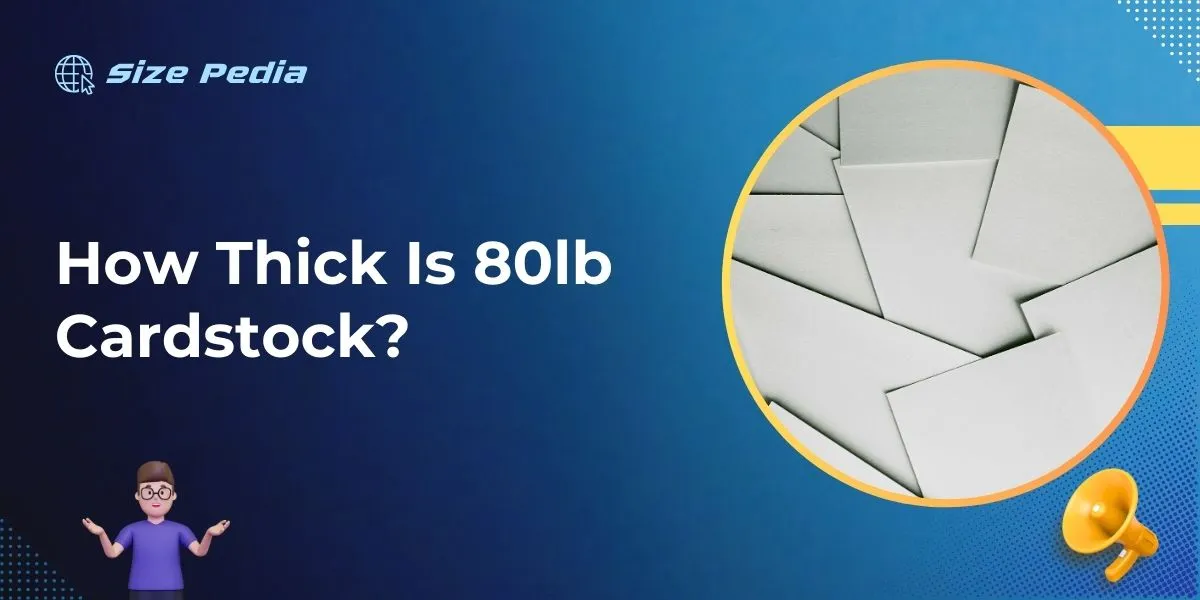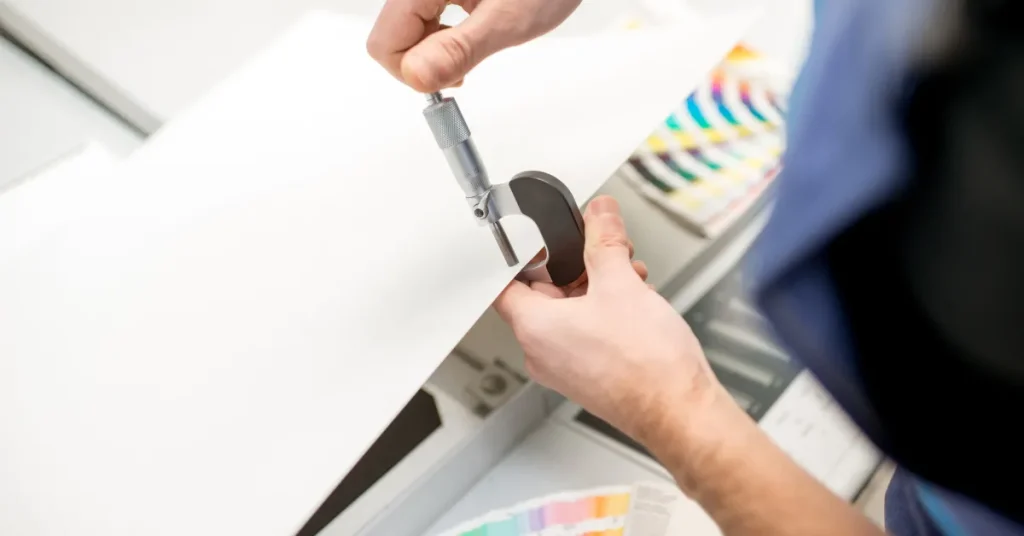80lb cardstock typically measures approximately 0.008 inches or 0.2032 millimeters thick. It is a popular choice for its durability and substantial feel.
Crafting a perfect invitation, business card, or brochure demands the right material—80lb cardstock offers a balance of thickness and workability, ensuring your project stands out.
This medium-weight cardstock serves as an excellent base for printing vibrant colors and sharp text, making it a favorite amongst professionals and hobbyists alike.
Its versatility extends across various printing methods such as inkjet, laser, and offset, proving to be a practical option for a multitude of creative endeavors.
Ideal for a professional finish without the heaviness of thicker stocks, 80lb cardstock remains a go-to choice for quality prints with a touch of elegance.

The Basics Of Cardstock
Think of cardstock as paper’s stronger cousin. It’s stiffer, thicker, and more durable. Party invitations, business cards, and scrapbooking often use it. Let’s dive into what cardstock is and how important weight is in paper.
What Is Cardstock?
Cardstock is a thick, rigid paper. It is stronger than standard writing or printing paper. Many projects and crafts rely on its thickness and durability.
The Significance Of Weight In Paper
Paper weight often confuses people. It is crucial for the right project outcome. Weight affects how paper feels and how it holds up to use and handling.
For 80lb cardstock, the “lb” refers to the weight of 500 sheets at a basic size. Although its thickness can vary, it’s generally about 0.009 to 0.011 inches.
| Weight Category | Approximate Thickness |
| 65lb Cardstock | 0.008 inches |
| 80lb Cardstock | 0.009 to 0.011 inches |
| 100lb Cardstock | 0.012 to 0.014 inches |
Heavier cardstock means a sturdier paper. Lighter weights bend easily. They work for simple prints or foldable items. Heavier options suit structures or bases. They resist warping and bending.
Choose weight based on project needs. Wedding invitations may call for a heavier weight. Office memos might opt for lighter stock. Always match the paper’s strength to its intended use.
Measuring Paper Thickness

When selecting cardstock for a project, thickness is key. It affects durability and the final look. Getting it right is essential for the desired effect on invitations, business cards, or book covers. Let’s dive into how to measure this crucial aspect.
Gsm Vs. Pound Rating
Paper thickness can confuse many. Different regions use different measurements. Most countries use GSM. The United States often uses pounds. Understanding both will help in making the right choice.
- GSM stands for grams per square meter. It’s a weight measure for paper.
- Pound rating is the weight of 500 standard-size sheets. The term ‘lb’ or ‘pound’ is common in the U.S.
80lb cardstock has a specific feel and thickness. Its GSM equivalent can help in comparisons. A typical 80lb cover stock is about 216 GSM.
Understanding The ‘point’ System
The ‘point’ system is another method to measure cardstock thickness. One point (pt) equals one-thousandth of an inch. This measurement gives a direct thickness level, making it practical and straightforward.
| Points | Corresponding Thickness (inches) |
| 10 pt | 0.010 inches |
| 14 pt | 0.014 inches |
To grasp how an 80lb cardstock feels, consider its thickness in points. An 80lb cover stock is often around 10 to 11 points, translating to 0.010 – 0.011 inches thick.
The Specifics Of 80lb Cardstock
Exploring the Specifics of 80lb Cardstock leads to a wealth of information. This type of cardstock is a popular choice.
Creative projects and professional prints often require a certain sturdiness. 80lb cardstock provides this resilience. Let’s delve into how thick this cardstock is and its various applications.
The Thickness Of 80lb Cardstock
To understand the thickness of 80lb cardstock, a comparison helps. It is thicker than printer paper but not as thick as cardboard. In terms of measurements, 80lb cardstock sits around 0.0092 inches thick. This translates to the following in metric units:
- 233 micrometers (µm)
- 0.233 millimeters (mm)
This thickness ensures the cardstock is sturdy without being too rigid.
Common Uses For 80lb Cardstock
Given its specific thickness, 80lb cardstock is versatile. It suits many applications where durability and a premium feel are important. These uses include:
- Greeting cards: Keeps the cards upright and durable.
- Business cards: Imparts a professional and solid feel.
- Postcards: Offers the right balance between flexibility and firmness.
- Cover pages: Adds a quality touch to reports and presentations.
- Invitations: Exudes elegance for special events.
Many opt for 80lb cardstock due to its balanced thickness. It effectively supports high-quality prints and vibrant colors.
Comparing Cardstock Densities
Understanding cardstock thickness is key for choosing the right material for your projects. The thickness of cardstock, or its weight, affects durability and feel.
Here we compare 80lb cardstock to other common weights to help you decide which is best for your needs.
Contrasting 80lb With Other Weights
Cardstock comes in various weights, each suited for different uses. The ‘lb’ or pounds, refers to the weight of 500 sheets of 20″ x 26″ paper. 80lb cardstock is a moderate thickness, versatile for many projects.
| Weight | Thickness (approx.) | Use-case |
| 65lb | 0.18 mm | More flexible, good for layering |
| 80lb | 0.21 mm | Sturdy for cards and covers |
| 100lb | 0.27 mm | Ideal for stand-alone use |
| 110lb+ | 0.29 mm & up | Best for heavy-duty applications |
Ideal Projects For Different Densities
Each cardstock weight has its place. Lighter weights are perfect for layering or brochures. Heavier stocks ensure durability for things like business cards.
- 65lb: Invitations, flyers, and multi-layer pieces.
- 80lb: Greeting cards, booklet covers, and art projects.
- 100lb: Business cards, certificates, and direct mail postcards.
- 110lb and up: Postcards, business card backing, and hang tags.
Choose the right density for your project for the best presentation and performance.
Choosing The Right Cardstock

Are you ready to pick the perfect cardstock for your project? Understanding the thickness is key.
The term ’80lb cardstock’ may sound technical, but it really just refers to the weight of 500 sheets of this paper sized to the basis size for its type. Here’s how to zero in on the right cardstock for your needs.
Factors To Consider
Thickness matters in cardstock projects. It affects durability, printability, and how the final product feels. The 80lb cardstock is a versatile choice. It is thick enough for sturdiness without being too bulky.
- Weight Rating: The ’80lb’ refers to the paper’s weight, not its actual thickness. Check the paper’s point thickness for precise measurements.
- Use: What is your project for? Invitations need different stock than business cards.
- Printer Compatibility: Thicker cardstock may not suit all printers. Check your printer’s specs before buying.
Expert Tips For Selection
Our experts have some advice to make your selection process smooth and successful. Remember these tips:
- Test Before You Buy: Print a test page to check quality.
- Consider Finish: Glossy, matte, or textured? Each has a different look and feel.
- Ask for Samples: Get a hands-on feel for thickness and texture.
Maximizing Cardstock In Your Projects
When it comes to crafting, 80lb cardstock offers a sturdy canvas for creativity. Maximizing Cardstock in Your Projects goes beyond just picking a color.
Understanding its thickness and the best ways to use it can transform your ideas into professional-looking creations. Let’s dive into how to make the most of this versatile material.
Creative Applications
- Custom Greeting Cards: Make any occasion special with a personal touch.
- Scrapbooking: Preserve memories with layers of textures and colors.
- Business Cards: Stand out with a firm handshake and a solid card.
- Invitations: Set the tone for your event before it even starts.
- Art Projects: From paper sculptures to bookmarks, bring your vision to life.
Best Practices For Handling
- Store Flat: Prevent bends and curls for a flawless finish.
- Score Before Folding: Achieve crisp edges in your folded projects.
- Use the Right Tools: Sharp scissors and knives make for clean cuts.
- Print Wisely: Ensure your printer can handle the cardstock’s weight.
- Adhesive Choice: Select the best glue or tape for a secure bond.
FAQs About How Thick Is 80lb Cardstock
Is 80 Lb Cardstock Thick?
Yes, 80 lb cardstock is considered thick, typically used for business cards, postcards, and invitations. It offers a sturdy feel and durability.
Is 80lb Or 100lb Paper Thicker?
100lb paper is thicker than 80lb paper. This increased thickness provides a sturdier and higher quality feel, ideal for premium print materials.
Which Is Thicker 90 Lb Or 110 Lb Cardstock?
The 110 lb cardstock is thicker than the 90 lb cardstock.
What Is The Average Thickness Of Cardstock?
The average thickness of cardstock ranges between 0. 23 mm to 0. 30 mm (230 to 300 gsm).
Conclusion
Grasping the specific thickness of 80lb cardstock is pivotal for your printing projects. This robust material offers durability and heft, enhancing the quality of your creations.
Remember that its weight reflects versatile uses, from business cards to invitations. Choose wisely, ensuring your final product exudes professionalism and style.
Resources:
1. https://www.cutcardstock.com/pages/paper-weights-explained
